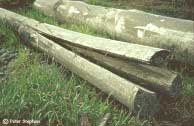|
|
|
Natural
growth stresses
The formation of tension and compression
stresses is common in many trees as a result of normal growth.
As new growth rings are laid down around the tree, a longitudinal—up
the tree—tensile stress is imposed as the cell walls mature.
This results in the log’s surface being under tension like
an elastic band. That tension is balanced by compression stresses—like
a compressed spring—in the central core. These stresses
can be very pronounced in eucalypts and can seriously affect
recovery rates and processing costs.

Growth stresses are often responsible for
end splitting in logs and bending in sawn boards. Backsawn boards
tend to bow as a result of longitudinal stresses whereas quartersawn
boards will spring. Bowing is of less concern because the boards
can be easily straightened; so mills may prefer to backsaw highly
reactive logs. Spring is difficult to correct without large
reductions in recovery.
Growth stresses are of less concern in larger diameter logs.
This is because the rate at which longitudinal stress increases
from the pith to the bark is greater in small diameter logs.
As a result, a piece of sawn timber cut from a small log is
expected to bend more than a piece of the same dimensions cut
from a larger log. For trees of the same diameter the growth
stresses are also expected to be greater in the taller trees.
This reflects the fact that the longitudinal stresses in the
trunk play an important role in holding the tree vertical. Rather
than inducing higher growth stresses, rapid diameter growth
actually reduces the problem.
Back to top
|
|
